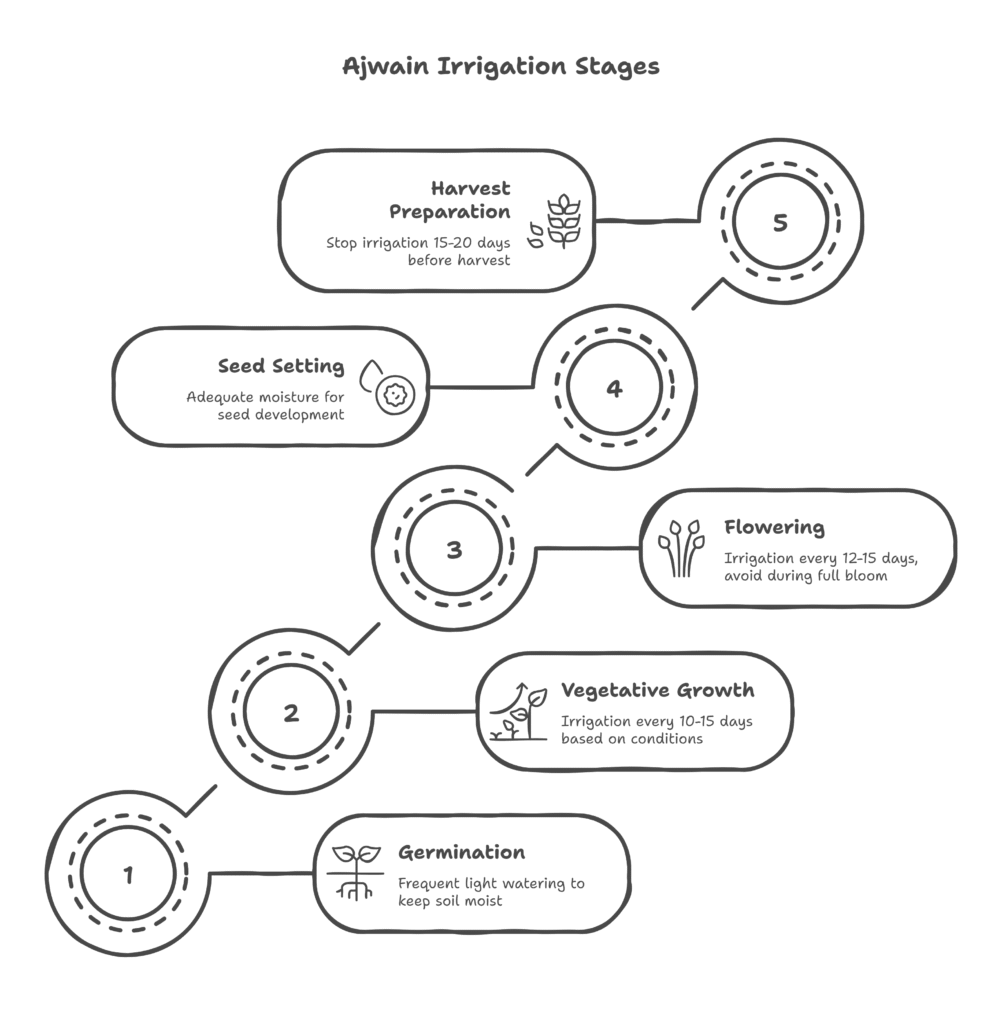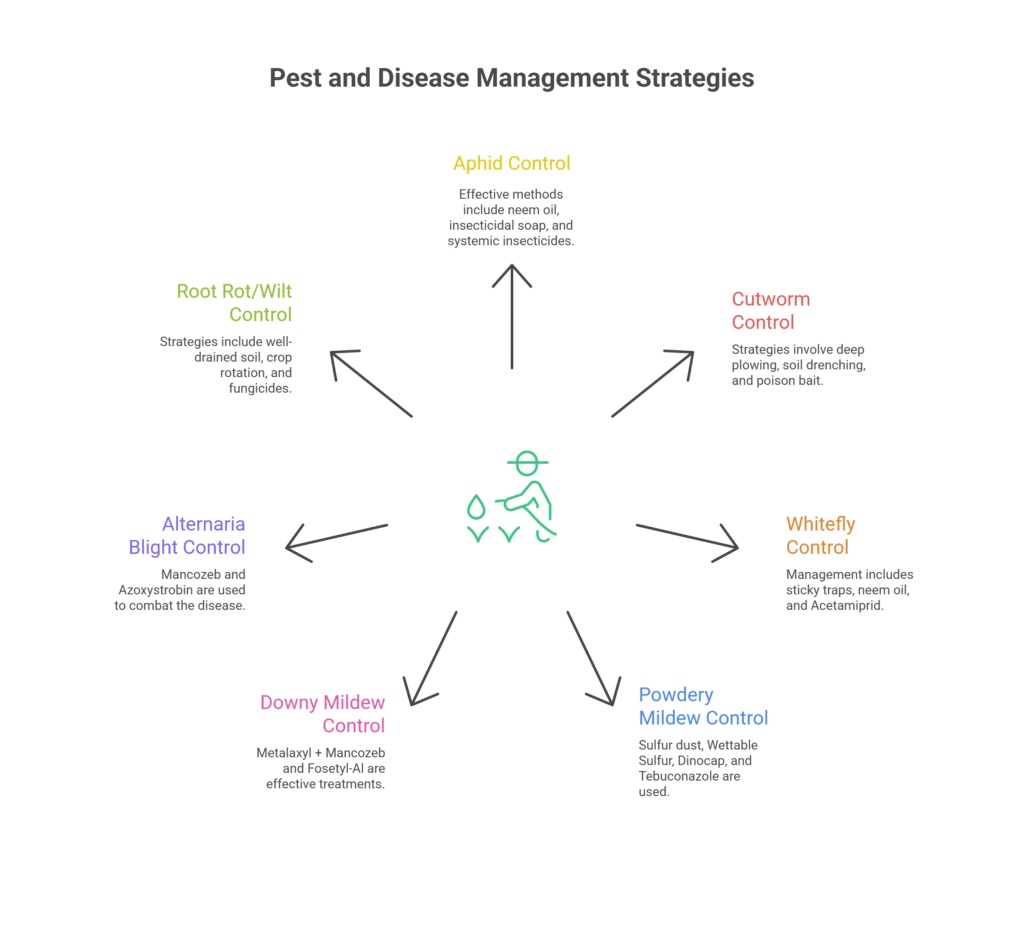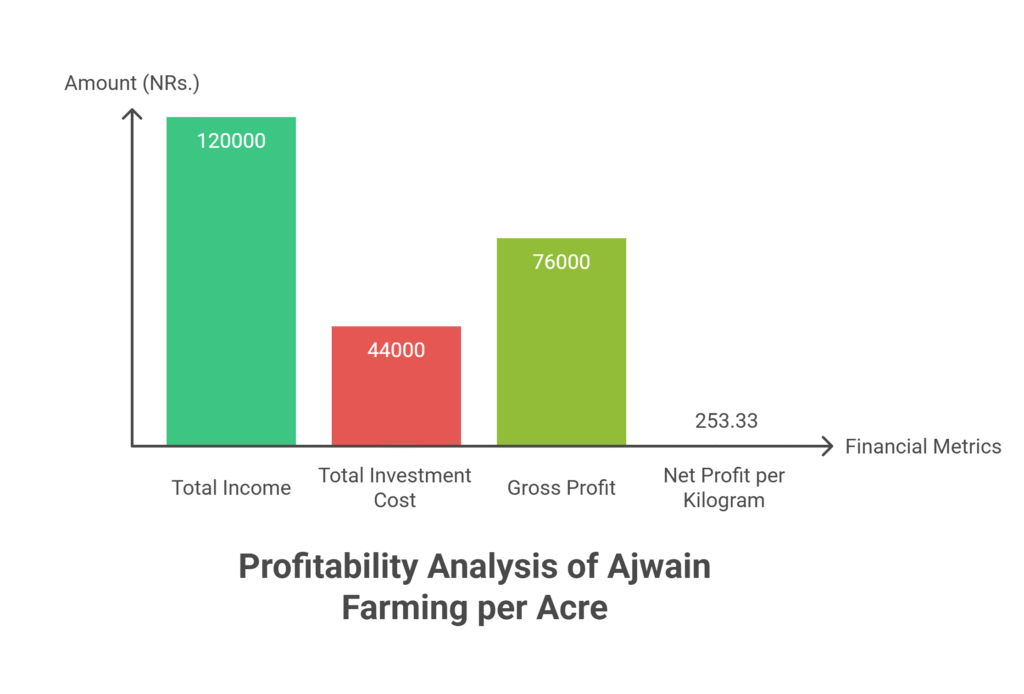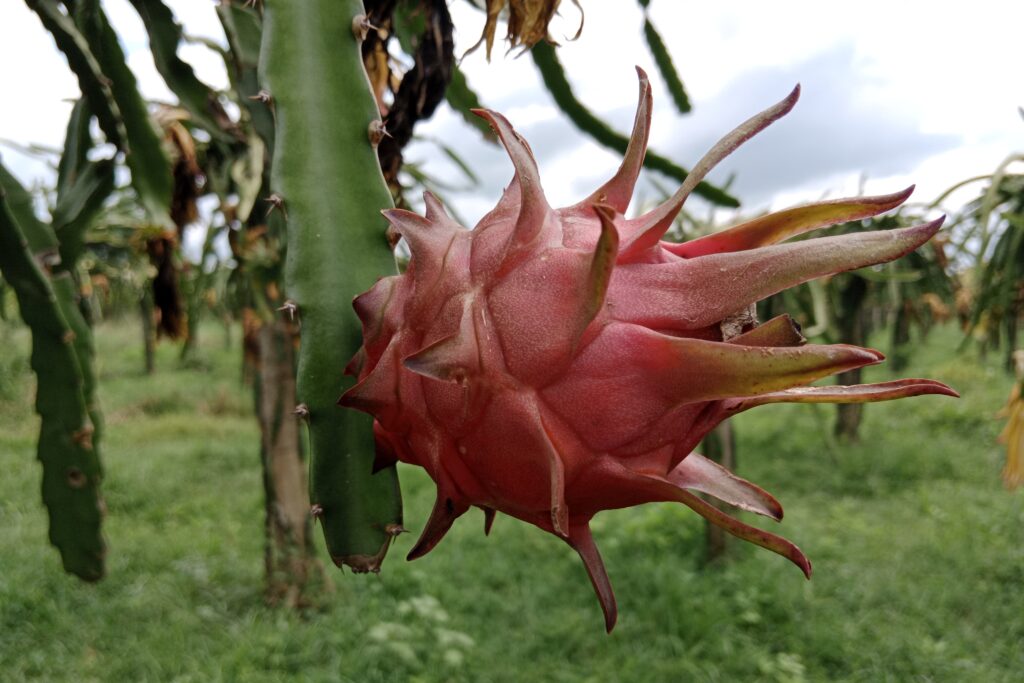Ajwain (Carom seeds) Farming
Carom seeds, commonly called Ajwain, are a significant medicinal plant and one of the major spices. Ajwain is grown for both its leaves and seeds, with the oil extracted from seeds widely used in making various medicines. This oil is effective in treating ailments like indigestion, stomach discomfort, and colds. Given its steady demand, cultivating Ajwain offers a profitable opportunity for farmers.

Ajwain farming profit per acre can be highly rewarding when managed efficiently. A typical profit analysis reveals that from one acre of cultivation, the total income can reach around NRs. 120,000, while the total investment cost is approximately NRs. 44,000. This results in a substantial gross profit of NRs. 76,000, reflecting a strong profit margin of 63.33%. With an average yield of 300 kg per acre, the net profit per kilogram of ajwain is about NRs. 253.33, demonstrating the economic viability and profitability of ajwain farming as an agricultural venture.
Land Preparation
Land preparation for ajwain cultivation begins with 1–2 deep plowings (8–10 inches) during summer, if possible, to expose the soil to sunlight, aid in decomposing organic matter, and eliminate pests and weeds. This is followed by 2–3 cross harrowings and planking to break clods, incorporate organic manure, and create a fine, firm, and level seedbed, which is essential due to the small size of ajwain seeds.
For rainfed cultivation, moisture conservation measures such as creating small bunds or compartments are recommended to retain rainwater. During the final harrowing, well-decomposed farmyard manure or compost should be incorporated, along with basal doses of phosphorus and potassium fertilizers as per soil test recommendations.
Soil Type
Ajwain thrives best in well-drained loamy to sandy loam soils enriched with organic matter, as these soil types offer an ideal balance of texture, aeration, and moisture retention, which supports healthy seed germination and strong root growth. Although ajwain is a resilient crop that can grow in various soils, including those with mild salinity or alkalinity, it is vulnerable to waterlogged conditions.
As such, heavy clay soils with poor drainage are unsuitable because they trap excess moisture, increasing the risk of root rot and negatively impacting plant health. A soil pH range of 6.5 to 8.0 is ideal, promoting better nutrient uptake and microbial activity in the root zone. Ensuring proper internal drainage is also essential to prevent water stagnation and support healthy crop development throughout the growing season.
Climatic Requirements
Ajwain is mainly grown as a cool-season (Rabi) crop, although it can also be cultivated during the summer in some areas with sufficient irrigation. The crop thrives in temperatures ranging from 15°C to 25°C, with seed germination occurring best between 15°C and 20°C. It prefers cool, dry conditions during early growth and requires warm, sunny weather for flowering and seed development, as these conditions enhance seed setting.

While mature ajwain plants can withstand mild frost, young seedlings are susceptible to frost injury. The crop grows well under rainfed conditions where rainfall is evenly distributed and totals 40–60 cm during the season, but irrigation becomes essential in arid zones or during extended dry periods. Excessive moisture or humidity during flowering and seed formation should be avoided, as it increases the likelihood of disease. For healthy growth and high yield, ajwain requires exposure to full sunlight throughout its lifecycle.
Major Cultivars
Ajwain cultivar development is less structured compared to major crops and is often based on local selections suited to regional conditions. Important traits considered in cultivar selection include seed yield, essential oil content (ranging from 2–5%), thymol concentration (35–60% of the oil), maturity period, and resistance to pests and diseases. Farmers generally prioritize ajwain varieties that offer high yields, possess a high thymol content, and are well adapted to local growing conditions to ensure better quality and profitability.
| State/Region | Variety Name(s) | Key Characteristics |
| Andhra Pradesh | Lam Selection 1, Lam Selection 2, R.A. 1-80, R.A. 19-80 | High yielding, regionally adapted |
| Gujarat | Gujarat Ajwain-1 (GA-1) | Prominent state variety, good yield |
| Rajasthan | Ajmer Ajwain-1, Ajmer Ajwain-2, Ajmer Ajwain-93, Pratap Ajwain-1, RA-1 | Improved varieties with better yield and quality |
| Other States | Local landraces in Madhya Pradesh, Uttar Pradesh, Bihar, Punjab, Tamil Nadu | Region-specific adaptability, preferred for local conditions |
Seed Rate per Acre
The recommended seed rate for ajwain typically ranges between 1.5 and 2.5 kg per acre, depending on factors like seed size and viability, with smaller seeds or those with lower germination requiring slightly higher quantities. Broadcasting demands more seed—around 2 to 2.5 kg per acre—while line sowing requires less, approximately 1.5 to 2 kg per acre.
In finely prepared, moist seedbeds, lower seed rates may be adequate. To prevent seed-borne diseases such as damping-off, seeds should be treated before sowing with fungicides like Thiram or Captan at 2–3 g per kg of seed, or with biological treatments such as Trichoderma viride at 4 g per kg of seed. Additionally, applying bioinoculants like Azospirillum or Azotobacter as seed treatments has been shown to enhance yields.
Planting
Ajwain is a cold-loving crop primarily cultivated during the Rabi season, although its planting time varies depending on the region; the typical planting periods are provided in the table to guide farmers accordingly.
| Planting Season | Time Frame | Conditions |
| Rainfed (Rabi) | Mid-October to Mid-November | After monsoon rains cease |
| Irrigated (Rabi) | Mid-October to December | Requires irrigation |
| Summer (Irrigated) | Mid-January to February | In regions with mild summers |
b). Spacing
For ajwain cultivation, use spacing of 45cm x 15cm.
c). Planting Method
Ajwain can be planted using two main methods: broadcasting and line sowing. Broadcasting involves mixing seeds with fine sand or soil for even distribution, then lightly covering them with soil or raking in followed by light rolling; this method is less efficient and requires intensive thinning later.
Line sowing, the preferred method, entails drilling or manually dropping seeds into shallow furrows about 1–2 cm deep, which are then lightly covered with soil and pressed or rolled; this ensures uniform spacing, facilitates easier weed control and intercultural operations, reduces seed usage, and still requires thinning to achieve the final plant spacing.
d). Number of Plants per Acre
Based on the spacing above spacing, approximately 59,955 ajwain plants can be grown per acre.
Intercropping
Ajwain is commonly intercropped, particularly in rainfed areas or during its slow initial growth phase, with suitable companions including short-duration, non-spreading crops planted between ajwain rows. Common intercrops in the Rabi season are pulses like chickpea, lentil, and fenugreek, as well as vegetables such as onion, garlic, and coriander (which are harvested early), and oilseeds like early-maturing mustard varieties.
Intercropping offers benefits such as more efficient use of land and water, risk diversification, and additional income. However, it is important to maintain adequate spacing for both crops, ensure the companion crop does not compete excessively for nutrients, water, or sunlight, and harvest the companion crop early to avoid affecting ajwain growth.
Irrigation
Irrigation is crucial for ajwain during germination, early seedling establishment, flowering, and seed development stages. In rainfed conditions, the crop depends on conserved soil moisture and timely winter rains, though supplemental irrigation during dry spells can significantly increase yields.

For irrigated crops, frequent light watering every 5–7 days during germination and establishment helps keep the surface soil moist without causing waterlogging. During vegetative growth, irrigation is typically applied every 10–15 days based on soil and weather conditions.
Adequate moisture is essential during flowering and seed setting, with irrigation every 12–15 days; however, irrigation or rainfall should be avoided during full bloom to prevent flower drop and disease.
Irrigation is stopped about 15–20 days before harvest when seeds begin to harden to ensure uniform ripening and reduce risks of disease and lodging. Furrow irrigation is commonly used, while light sprinklers may be applied cautiously during establishment but should be avoided during flowering.
Fertilizer and Manure
The typical range of inorganic fertilizer recommended for ajwain cultivation per acre should be adjusted based on soil test results to ensure balanced nutrient application. The general guidelines are given below
| Category | Specific Type | Quantity per Acre | Application Timing/Method | Notes |
| Organic Matter | Well-decomposed FYM or Compost | 8-10 tons | During land preparation | Essential for soil fertility and structure |
| Biofertilizers | Azospirillum | 800 g | At sowing (basal application) | Nitrogen fixation |
| PSB (Phosphate Solubilizing Bacteria) | 800 g | At sowing (basal application) | Enhances phosphorus availability | |
| Potash Mobilizing Bacteria | 800 g | At sowing (basal application) | Improves potassium uptake | |
| Mycorrhiza | 4 kg | At sowing (basal application) | Enhances nutrient and water absorption | |
| Inorganic Fertilizers | Nitrogen (N) | 12 kg | Split: 6 kg basal, 6 kg top-dressed 30-40 DAS | Avoid excess to prevent lodging and delayed maturity |
| Phosphorus (P₂O₅) | 16 kg | Full dose as basal application | Applied during land preparation | |
| Potassium (K₂O) | 12 kg | Full dose as basal application | Especially critical in light soils | |
| Sulfur (S) | 8-10 kg | Basal application | Beneficial for essential oil content in seeds |
Weed Control
Weed control plays a vital role in ajwain cultivation, especially during the first 6–8 weeks when the crop grows slowly and is highly susceptible to weed competition. An integrated approach combining cultural, mechanical, and chemical methods is most effective.
Culturally, using a clean seedbed and weed-free seeds helps reduce early weed pressure. Mechanically, 2–3 shallow hoeings and manual weedings should begin around 20–25 days after sowing and continue until the crop canopy covers the ground, particularly in broadcast-sown fields.
Chemically, pre-emergence herbicides like Pendimethalin at 1.0 kg a.i./acre or Oxyfluorfen at 0.15–0.2 kg a.i./acre can be applied immediately after sowing to control initial weed emergence. Post-emergence herbicide use is limited and should be approached with caution, ensuring proper labeling and necessity. Hand weeding remains essential during later growth stages to maintain effective weed control.
Flowering and Fruit Management
Ajwain begins flowering 60–80 days after sowing, producing small white flowers arranged in compound umbels characteristic of the Apiaceae family, with the main flowering period lasting 2–3 weeks. The crop is primarily cross-pollinated by insects such as bees and flies.
Following pollination, the flowers develop into small, ovoid, ridged green fruits (schizocarps) that gradually turn brownish-grey upon maturity, with seeds ripening unevenly and prone to shattering when fully mature.
Effective management during this stage involves maintaining adequate moisture and nutrient levels to avoid stress, avoiding rainfall or overhead irrigation during flowering to prevent flower drop and seed-borne diseases, and ensuring timely harvesting to minimize seed shattering losses.
Pest and Disease Management
Common Pests
a). Aphids
Aphids are sap-sucking insects that distort plant growth and excrete sticky honeydew, which can attract sooty mold; they can be effectively controlled by spraying neem oil at 0.5%, using insecticidal soap, or applying systemic insecticides like Imidacloprid or Dimethoate at a concentration of 1 ml per liter of water.
b). Cutworms
Cutworms are destructive pests that sever seedlings at the soil level, causing significant crop loss; effective control measures include deep plowing to expose larvae, soil drenching with a mixture of Profenophos and Cypermethrin at 2 ml per liter of water, and the use of poison bait to reduce their population.
c). Whiteflies
Whiteflies are sap-sucking insects that also transmit harmful plant viruses, leading to stunted growth and reduced yields; they can be managed by using yellow sticky traps for monitoring and trapping, spraying neem oil, or applying Acetamiprid at 1 ml per liter of water, with a recommended volume of 200 liters of spray solution per acre.

Common Diseases
a). Powdery Mildew
Applying sulfur dust at 25–30 kg/ha, spraying Wettable Sulfur at 2.5 g/liter of water, using Dinocap at 1 ml/liter, or using systemic fungicides like Tebuconazole at 1 ml/liter are all effective ways to control powdery mildew, which manifests as white, powdery growth on leaves and stems and reduces photosynthesis and plant vigor.
b). Downy Mildew
Downy mildew is characterized by yellow patches on the upper leaf surface and purplish downy fungal growth on the underside, commonly occurring in cool, wet conditions; it can be effectively managed by spraying a combination of Metalaxyl + Mancozeb at 2.5 g/liter of water or Fosetyl-Al at 2 g/liter, with repeat applications at 7–10 day intervals depending on disease pressure.
c). Alternaria Blight
Alternaria blight is a fungal disease marked by brown spots with concentric rings on leaves and stems, commonly favored by warm, humid conditions; it can be effectively controlled by spraying Mancozeb at 2.5 g/liter of water or Azoxystrobin at 1 ml/liter, with applications repeated every 7–10 days based on disease severity.
d). Root Rot/Wilt (Fusarium, Rhizoctonia)
Root rot and wilt, caused by fungi like Fusarium and Rhizoctonia, lead to wilting, stunted growth, and root decay, particularly under waterlogged conditions; effective management includes ensuring well-drained soil, practicing crop rotation, treating seeds with Carbendazim or Thiophanate Methyl at 2 g/kg seed, and soil drenching with either fungicide at 2 g/liter of water to suppress pathogen buildup.
Harvesting
Harvesting must be done with precision, usually between 150 to 180 days after sowing, when seeds in the primary umbels turn brownish-grey, become firm, and the umbels start drying, along with the stems. Delayed harvesting can lead to significant seed shattering.
A reliable indicator is when seeds in the main umbels feel hard and gritty when pressed, even if the secondary umbels remain slightly green. Harvesting is best carried out early in the morning while dew is present to reduce seed loss, by cutting the whole plant or branches bearing mature umbels close to the ground.
The cut material should be spread in a thin layer on clean tarpaulins or concrete surfaces and sun-dried for 3 to 5 days, with regular turning. Once fully dried, threshing should be done either manually by beating with sticks or using a light thresher to separate the seeds, followed by winnowing to remove dust and chaff. To ensure safe storage, the cleaned seeds should be sun-dried for an additional 2 to 3 days until moisture content falls below 10%, and care should be taken during handling to avoid seed breakage.
Yield
Under rainfed conditions, seed yield ranges from 200 to 400 kg per acre, while irrigated fields can produce between 400 and 800 kg per acre. Biomass or herbage/straw yield is typically 1,500 to 2,500 kg per acre, which can also be utilized for essential oil extraction, although the oil quality is generally lower compared to that extracted from seeds. The essential oil yield from seeds is approximately 2–4% of their weight, resulting in about 8 to 32 kg of oil per acre.
Cost of Investment Per Acre for Ajwain Farming
| S.N. | Categories | Cost (NRs.) |
| 1 | Land Preparation (plowing) | 15,000 |
| 2 | Seed (Planting material) | 1,000 |
| 4 | Planting | 2,000 |
| 5 | Fertilizers and Manure | 8,000 |
| 6 | Irrigation | 3,000 |
| 7 | Weed Control (pre & post-emergence) | 2,000 |
| 8 | Pest & Disease Control | 3,000 |
| 9 | Harvesting | 5,000 |
| 10 | Miscellaneous Costs | 5,000 |
| Total Cost | 44,000 |
Income from per Acre Ajwain Farming
| Particulars | Estimated Yield (kg) | Market Price (NRs/kg) | Total Income (NRs.) |
| Ajwain Seed yield | 300 | 400 | 120,000 |
Analysis of Ajwain Farming Profit Per Acre
| Metric | Calculation | Amount (NRs.) |
| Total Income | – | 120,000 |
| Total Investment Cost | – | 44,000 |
| Gross Profit | 120,000 – 44,000 | 76,000 |
| Profit Margin | (76,000 / 120,000) × 100% | 63.33% |
| Net Profit per kg | 76,000 / 300 kg | 253.33 |
Crop Calendar
The crop calendar is based on Rabi season planting (October–November) in most regions. Adjust by ±30–45 days for summer planting (January–February).
| Month | Stage | Key Activities | Duration/Days | Special Notes |
| Sep–Oct | Land Preparation | Deep plowing (8–10 inches), 2–3 harrowings, soil leveling. Apply FYM (8–10 tons) and basal fertilizers (P, K, S). | 2–3 weeks | Ensure fine, firm seedbed. Create bunds for rainfed areas. |
| Oct–Nov | Sowing | Optimal window: Mid-Oct to Mid-Nov (rainfed), Oct–Dec (irrigated). Method: Line sowing (45cm × 15cm). Seed rate: 1.5–2 kg/acre (treated). | 1–2 days | Use biofertilizers (Azospirillum, PSB) with seeds. Avoid deep sowing (>2 cm). |
| Nov–Dec | Seedling Stage | Light irrigation every 5–7 days. Pre-emergence weed control (Pendimethalin). First manual weeding at 20–25 DAS. | 0–30 DAS | Protect seedlings from frost. Monitor for cutworms/aphids. |
| Dec–Jan | Vegetative Growth | Top-dress nitrogen (6 kg/acre). Second weeding + hoeing. Irrigation every 10–15 days. | 30–60 DAS | Control weeds aggressively. Avoid waterlogging. |
| Jan–Feb | Flowering Initiation | Flowering starts: 60–80 DAS. Ensure soil moisture (irrigate every 12–15 days). Spray neem oil for pest prevention. | 60–90 DAS | No overhead irrigation during full bloom. Monitor whiteflies/aphids. |
| Feb–Mar | Seed Development | Critical irrigation for seed filling. Spray fungicides (e.g., Mancozeb) if diseases appear. Stop irrigation 15–20 days pre-harvest. | 90–120 DAS | Avoid humidity to prevent powdery mildew. Check seed hardness. |
| Apr–May | Maturity & Harvest | Harvest when: Seeds turn brownish-grey (150–180 DAS). Cut plants at dawn; dry 3–5 days. Thresh, winnow, and sun-dry seeds. | 150–180 DAS | Delay causes shattering. Ensure seed moisture <10% befo |
Sources
ICAR-Directorate of Medicinal and Aromatic Plants Research (DMAPR), Anand
National Horticulture Board (NHB), India
Nepal Agricultural Research Council (NARC)
Rajasthan Agricultural Research Institute (RARI), Jaipur
Gujarat Agricultural University



